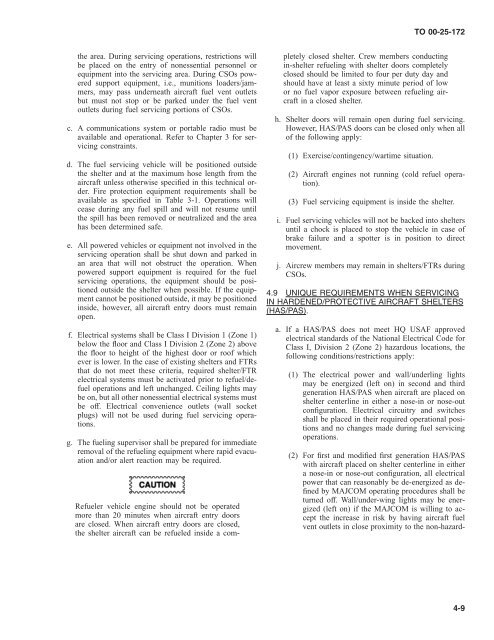TO 00-25-172 - Robins Air Force Base
TO 00-25-172 - Robins Air Force Base
TO 00-25-172 - Robins Air Force Base
You also want an ePaper? Increase the reach of your titles
YUMPU automatically turns print PDFs into web optimized ePapers that Google loves.
<strong>TO</strong> <strong>00</strong>-<strong>25</strong>-<strong>172</strong><br />
the area. During servicing operations, restrictions will<br />
be placed on the entry of nonessential personnel or<br />
equipment into the servicing area. During CSOs powered<br />
support equipment, i.e., munitions loaders/jammers,<br />
may pass underneath aircraft fuel vent outlets<br />
but must not stop or be parked under the fuel vent<br />
outlets during fuel servicing portions of CSOs.<br />
c. A communications system or portable radio must be<br />
available and operational. Refer to Chapter 3 for servicing<br />
constraints.<br />
d. The fuel servicing vehicle will be positioned outside<br />
the shelter and at the maximum hose length from the<br />
aircraft unless otherwise specified in this technical order.<br />
Fire protection equipment requirements shall be<br />
available as specified in Table 3-1. Operations will<br />
cease during any fuel spill and will not resume until<br />
the spill has been removed or neutralized and the area<br />
has been determined safe.<br />
e. All powered vehicles or equipment not involved in the<br />
servicing operation shall be shut down and parked in<br />
an area that will not obstruct the operation. When<br />
powered support equipment is required for the fuel<br />
servicing operations, the equipment should be positioned<br />
outside the shelter when possible. If the equipment<br />
cannot be positioned outside, it may be positioned<br />
inside, however, all aircraft entry doors must remain<br />
open.<br />
f. Electrical systems shall be Class I Division 1 (Zone 1)<br />
below the floor and Class I Division 2 (Zone 2) above<br />
the floor to height of the highest door or roof which<br />
ever is lower. In the case of existing shelters and FTRs<br />
that do not meet these criteria, required shelter/FTR<br />
electrical systems must be activated prior to refuel/defuel<br />
operations and left unchanged. Ceiling lights may<br />
be on, but all other nonessential electrical systems must<br />
be off. Electrical convenience outlets (wall socket<br />
plugs) will not be used during fuel servicing operations.<br />
g. The fueling supervisor shall be prepared for immediate<br />
removal of the refueling equipment where rapid evacuation<br />
and/or alert reaction may be required.<br />
Refueler vehicle engine should not be operated<br />
more than 20 minutes when aircraft entry doors<br />
are closed. When aircraft entry doors are closed,<br />
the shelter aircraft can be refueled inside a completely<br />
closed shelter. Crew members conducting<br />
in-shelter refueling with shelter doors completely<br />
closed should be limited to four per duty day and<br />
should have at least a sixty minute period of low<br />
or no fuel vapor exposure between refueling aircraft<br />
in a closed shelter.<br />
h. Shelter doors will remain open during fuel servicing.<br />
However, HAS/PAS doors can be closed only when all<br />
of the following apply:<br />
(1) Exercise/contingency/wartime situation.<br />
(2) <strong>Air</strong>craft engines not running (cold refuel operation).<br />
(3) Fuel servicing equipment is inside the shelter.<br />
i. Fuel servicing vehicles will not be backed into shelters<br />
until a chock is placed to stop the vehicle in case of<br />
brake failure and a spotter is in position to direct<br />
movement.<br />
j. <strong>Air</strong>crew members may remain in shelters/FTRs during<br />
CSOs.<br />
4.9 UNIQUE REQUIREMENTS WHEN SERVICING<br />
IN HARDENED/PROTECTIVE AIRCRAFT SHELTERS<br />
(HAS/PAS).<br />
a. If a HAS/PAS does not meet HQ USAF approved<br />
electrical standards of the National Electrical Code for<br />
Class I, Division 2 (Zone 2) hazardous locations, the<br />
following conditions/restrictions apply:<br />
(1) The electrical power and wall/underling lights<br />
may be energized (left on) in second and third<br />
generation HAS/PAS when aircraft are placed on<br />
shelter centerline in either a nose-in or nose-out<br />
configuration. Electrical circuitry and switches<br />
shall be placed in their required operational positions<br />
and no changes made during fuel servicing<br />
operations.<br />
(2) For first and modified first generation HAS/PAS<br />
with aircraft placed on shelter centerline in either<br />
a nose-in or nose-out configuration, all electrical<br />
power that can reasonably be de-energized as defined<br />
by MAJCOM operating procedures shall be<br />
turned off. Wall/under-wing lights may be energized<br />
(left on) if the MAJCOM is willing to accept<br />
the increase in risk by having aircraft fuel<br />
vent outlets in close proximity to the non-hazard-<br />
4-9
















